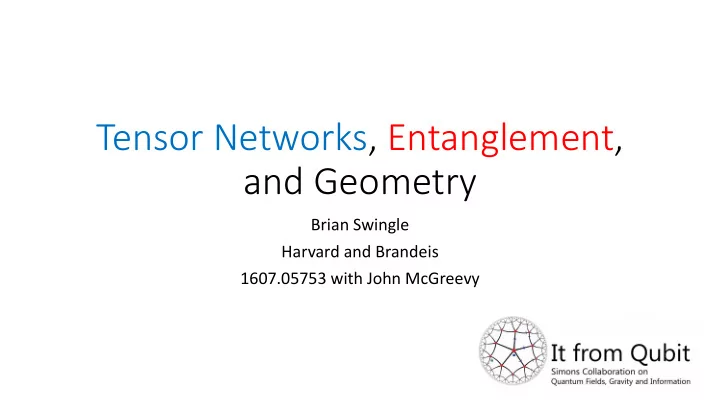

Tensor Networks, Entanglement, and Geometry Brian Swingle Harvard and Brandeis 1607.05753 with John McGreevy
Is quantum many- body physics “hard”? • Experimental answer: obviously yes! • Complexity answer: yes, because we can encode hard problems into quantum many-body physics – BQP, QMA, NP, glasses, and all that • Hopeful theorist’s answer: certainly in some cases, but perhaps not in many (still poorly understood) cases of physical interest? • By “easy” I mean: a problem that can be solved in polynomial time on a classical computer, caveats: physical intuition/understanding?, unfavorable polynomial scaling?
Two potentially “easy” classes? • Ground states or thermal states of quantum field theories • Why? Renormalization group structure of entanglement efficient tensor network representations (for regulated field theory) [Vidal “MERA”, BGS - McGreevy “s -sourcery ”, …] • Non-equilibrium steady states • Why? Coupling to environment decoherence, low entanglement, local thermal equilibrium [Prosen-Znidaric , many others …] • Today: a systematic quantum information approach to construct efficient classical representations of such states (and a connection to gravity) [BGS-McGreevy 1607.05753, Mahajan-Freeman-Mumford-Tubman-BGS 1608.05074]
Thermal states Local in space, few-body, translation invariant • Typically have short-range correlations (except classical critical points) • Area law for mutual information [Wolf-Cirac-Hastings-Verstraete] • Always “trivial” for sufficiently high temperature
“Hydrodynamic” states • Local thermal equilibrium • Generically carry currents, e.g. charge and heat
Non-interacting fermions solve using momentum eigenstates thermal physics
Fermion thermal circuit • Intuitively, the fermion thermal state should be easily preparable • Construction: [BGS-McGreevy 1607.05753] • Introduce second copy of system • Find two-copy gapped Hamiltonian whose ground state is a purification of the original thermal state • Adiabatically evolve down from infinite temperature interaction range in real space is the thermal length family of Hamiltonians, gapped, bounded range, infinite T ground state is product
What about the fermion system generalizes? conditional mutual information if B is large enough [BGS-McGreevy 1607.05753]
Small CMI generalizes: conformal field theory exact for any CFT in 1+1d large x [BGS-McGreevy 1607.05753]
Reconstruction from small CMI • When the conditional mutual information is zero, there is an exact reconstruction map that depends only on and [Petz] • When the conditional mutual information is small, there is an approximate reconstruction map that depends only on and [Fawzi-Renner, Sutter-Fawzi- Renner, Wilde…] • Essentially, we are gluing local together to produce the global state very much like hydrodynamics
General entropic argument • For many quantum field theories (and quantum lattice models) at non-zero temperature, we expect the CMI of appropriate regions to approximately vanish • Entropy S = [Volume Terms] + [Area Terms] + [Small corrections] • Can be explicitly checked for a wide variety of models and is always valid at sufficiently high temperature, can fail for topological models e.g. 4d toric code / 2-form gauge theory • Main result: Combining CMI reconstruction results with a cellular construction shows that suitable thermal states can be efficiently prepared by short-range quantum channel [BGS-McGreevy 1607.05753]
0-cell 1-cell 2-cell
buffer, 0 1
buffer, 1 2
Tile the plane with these unit cells:
Bubble of nothing array
Main result • Given: a state of n qubits with vanishing CMI for appropriate regions • Result: there exists a pure state on a doubled system which is (approximately) the unique gapped ground state of a local Hamiltonian and which is adiabatically connected to a product state [BGS-McGreevy 1607.05753]
Connections to geometry and gravity • AdS/CFT or holographic duality asserts: certain quantum field theories without gravity are exactly equivalent to certain quantum gravities in a higher dimension [Maldacena] • Emergent direction is associated with energy scale in the field theory, an “RG direction”
Spacetime as a tensor network [BGS] Scale invariant CFT ground state
Hydrodynamic states in AdS/CFT boundary locally boosted black hole horizon [Bhattacharyya-Hubeny-Minwalla-Rangamani]
Matching the tensor network and black hole descriptions • AdS/CFT: thermal states of CFTs with holographic duals have approximately vanishing CMI [BGS-McGreevy 1607.05753] • Remains true for hydrodynamic CFT states dual to hydrodynamic black holes [BGS-Hubeny coming soon] • In both cases, we have a patch description of the state • Thermal scale chunks of the density matrix – local currents • Thermal scale patches of the black hole horizon – local boosts
Summary and work-in-progress • Main result: efficient quantum information based representation of thermal states for a wide variety of quantum phases of matter • Does the representation have an RG structure on scales smaller than the thermal scale? • Can we derive hydrodynamic-like equations for the representation? • Can we use the representation to make new calculations in strongly interacting systems? THANK YOU
Recommend
More recommend